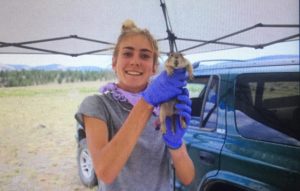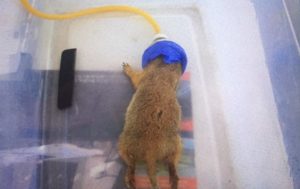 Hello! My name is Soleil Gaylord and I am a member of the 2017 Pinhead Intern Program. I am utilizing this incredible opportunity by working with Andrew Martin and his grad students at University of Colorado Boulder. However, most of my time will not be spent on the campus. I will be working around the state of Colorado doing field work, mostly on 5-8 day camping trips. I will be experiencing the true essence of what it is like to be a field biologist. On these trips, we will be working with the native Greenback Cutthroat Trout and the Gunnison’s prairie dog. We will be trapping and analyzing genetic information from these species as we discover their speciation within the state of Colorado!
Hello! My name is Soleil Gaylord and I am a member of the 2017 Pinhead Intern Program. I am utilizing this incredible opportunity by working with Andrew Martin and his grad students at University of Colorado Boulder. However, most of my time will not be spent on the campus. I will be working around the state of Colorado doing field work, mostly on 5-8 day camping trips. I will be experiencing the true essence of what it is like to be a field biologist. On these trips, we will be working with the native Greenback Cutthroat Trout and the Gunnison’s prairie dog. We will be trapping and analyzing genetic information from these species as we discover their speciation within the state of Colorado!
During my first week I worked with Dr. Andrew Martin’s evolutionary biology student, Sean Streich, and his team. Sean’s Ph.D. thesis examines the genetic divergence of the Gunnison’s prairie dog Cyanomsis gunnisoni and its subspecies, zooniensis. He is mapping the boundaries where this speciation takes place throughout the range of the Gunnison’s prairie dog in Colorado and New Mexico.
This type of science is called biogeography. I assisted in the labor intensive fieldwork, rising at 4:45 AM and going to bed late at night after data had been recorded. The main focus of the field work was the collection of genetic material or DNA from the prairie dogs without causing any mortality and with minimal stress to the small semi-fossorial mammals. In order to collect DNA, we first had to set traps. We trapped three different colonies: Big Rock Springs in Rio Grande National Forest, a colony near the New Mexico border, and a colony near Cochetopa Pass.
We used Tomahawk Live Traps that work perfectly and cause no harm. We then collected the prairie dogs by putting them in a bag and lightly sedating them. Each day we were able to trap about 20 to 30 individuals. Processing each one individually, we worked to minimize the amount of time each was handled and released them back to the exact same spot where they were collected. The prairie dogs were anesthetized with isoflourine gas. We then weighed each individual by zeroing the bag and then using a hand scale. Each individual was then pit tagged, which is a electronic marker placed in the right ear. This enables researchers to re-identify any future trapped animals for scientific baseline studies.
by putting them in a bag and lightly sedating them. Each day we were able to trap about 20 to 30 individuals. Processing each one individually, we worked to minimize the amount of time each was handled and released them back to the exact same spot where they were collected. The prairie dogs were anesthetized with isoflourine gas. We then weighed each individual by zeroing the bag and then using a hand scale. Each individual was then pit tagged, which is a electronic marker placed in the right ear. This enables researchers to re-identify any future trapped animals for scientific baseline studies.
Prairie dog blood was then drawn from the saphenous artery and placed in test tubes, which contain DNA preserving buffer, and then placed in dry ice tubes. Specimens were also orally swabbed as a secondary means to support DNA analysis. We then brought them back to their burrows to be released. It was tedious and difficult work, but super fun and interesting to be learning about native species.
We camped, staying in remote and beautiful high elevation areas: ponderosa pine biomes located from 7,000 to 8,000 feet. A bonus of doing research all day is getting to spend the evening and supper hours sitting around the fire discussing science with undergrad and grad students. This is helpful to me at this time in my life. After working at another site next week, we will run the blood sampling data through electrophoresis and the mitochonidral DNA which will be sent to a lab for analysis to determine which species presented at each site. Then, we will add this genetic data to an ongoing database detailing the genetic composition of populations throughout the state and how they are related and/or genetically diverged, and how this relates to the geography of their habitats.

There are no comments published yet.